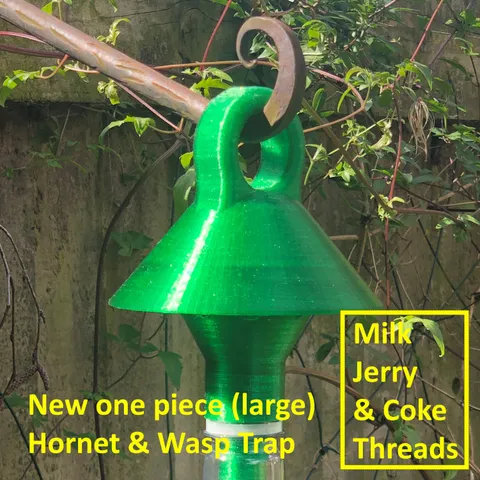
Wasp (& Hornet) Traps
prusaprinters
This is a set of wasp (& hornet) trap attachments for common (discarded) domestic food packaging containers. They will fit plastic milk, mineral water, carbonated-drink and jerry can containers (see specs below). Re-cycle the traps and containers after use.UPDATE [May23]. The set now includes one-piece ‘large’ trap funnels that will trap hornets as well as wasps. 3 designs have been added [Milk, Jerry & coke threads]. The new design meets all application options. Free-standing or hung up. They are also stronger, generate less waste and use less filament than a funnel and hangar combination. All print inverted. GCode for Mk3 & Mk4 included.Print the trap parts in PETG to ensure they are suitable for external use (UV and water exposure). Print parts in GREEN or WHITE; wasps are well tuned to green (many prey insects are green). Do not print in yellow, red or blue since this increases the chances of unintentional bee capture. Do not print in black, brown or dark colours (reduces effectiveness - dark colours are perceived as a predator threat and will drive wasps away).To create a wasp-trap select the funnel required for your container (threads vary). The simpleset way is to print the one-piece traps. The Small One-Piece Wasp trap only fits coke thread bottles and is only intended for small 300 to 500ml bottles. Large one-piece traps take any bottle / container size. If you are going to stand the trap up, save on filament and just print the trap, you can always print a hangar (also supplied) later if required.The large trap (including the new one-piece large traps) have a geometry that will facilitate the capture of both wasps & Hornets (Wasp: Common wasp, German wasp and north American Yellow Jacket) (Hornet: European & Asian). The small one-piece trap (intended for small fizzy drink bottles) has outer apertures that will struggle to capture hornets (only for wasps: Common wasp, German wasp and north American Yellow Jacket).All trap designs have a built-in hood to avoid rain dilution and to concentrate volatile attractants around / within the trap entrance.Printing: All traps print inverted. One piece designs print inverted and require some minor support. The g-codes have support built in already. if using STL’s then it’s quicker to use enforced support, remember to add a column for the centre of the hanging loop as well as the bottom outer arcs (when inverted) of the hanging loop. No other support required. If using the original 2 piece traps then the funnel hangar prints right way up without supports. Container specifications:MILK fits: 38mm neck Bericap (Milk jug containers - normally 0.568(1pt), 2.000, 2.273(4pt) 3.410(6pt) ltr capacity)COKE fits: 28mm neck mineral water and carbonated drink bottles with PCO1810 threads [Int 21.74mm; single start 720deg thread]JERRY fits: 38mm neck standard Jerry Can (typically 1.0, 2.5 & 5.0Ltr capacity) [Int 31.5mm, Thread OD -37.3] Print Times (PETG):Large 1 piece (v3) = 16 hours Small 1 piece (v1) = 6 hoursMulti-use (v2) - no integral hanger = 7 hours V2 hanger = 6 hours Wasp / Hornet Trap Bait: Do not use honey as bait, you will attract and kill honey bees. Bait varies depending on what you are trying to attract. Wasp Bait. I use cheap fruit jam. Melt the jam in a pan with the same amount of water. Add the smallest drop of washing-up liquid (breaks surface tension) and a drop of spirit vinegar (mildly acidifies and better replicates fallen fruit). You need enough liquid to drown the wasps (although once in the trap they are very unlikely to escape). As a quick attractant use cheap UHT apple juice plus a drop of washing-up liquid (do not use UHT orange juice - it is too acidic).Hornet Bait (including Asian Hornet if you are a monitoring beekeeper). Spring / early summer as for wasps and likely to catch queens. Later in the season when hornets become predatory they are targeting protein. Use some frozen fish or prawns and dilute 1:3 with water (also works for mid season wasps). Note: the protein solution will need replacing every 3-4 days since it will readily rot. For late season as nests break up, bait as for wasps.Ecological notes: Most wasps do not trouble humans or honey bees. I am a beekeeper; I do not kill wasps mindlessly / without reason. Wasps (including common, German and yellow jackets) are a valuable ecological group. Early in the season they capture a high volume of crop pest insects e.g. aphids (for protein to raise young) and help provide natural balance. Adult wasps then require carbohydrate energy sources. Unlike honey bees, a wasp colony does not ‘over-winter’, all adult wasps die; except for the queens that hibernate and emerge in spring. As adult wasp numbers peak, they will predate bee colonies for honey and nectar; killing the colony. Hornets will predate honey bee colonies for both protein (adult bee thorax and bee pupa) and carbohydrate (nectar and honey); again, killing the colony. Often wasps will become a domestic problem later in the season as numbers peak and they seek any carbohydrate source (they often also mistake alcoholic drinks for fermenting fallen fruit). If you have a local problem, of course, set traps; but please do not kill wasps without good cause, especially early in the season. If you are trapping wasps late in the season then these will likely be redundant adult worker wasps that would have died anyway (without making any further colony contribution).
With this file you will be able to print Wasp (& Hornet) Traps with your 3D printer. Click on the button and save the file on your computer to work, edit or customize your design. You can also find more 3D designs for printers on Wasp (& Hornet) Traps.
